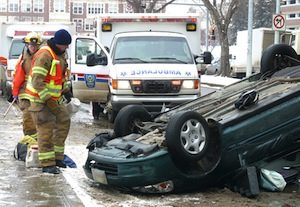 Each year approximately 250,000 rollover accidents occur in the United States. The National Highway Safety Administration says that “rollover accidents comprise a disproportionately large number of highway fatalities.” The NHTSA also says that, although rollover crashes account for only three percent of vehicles in accidents, they lead to approximately one-third of all occupant deaths.America has been relying on Sports Utility Vehicles (SUVs) to transport families, lulling the public into a sense that an SUV is a safe vehicle. However, SUVs and trucks have a higher tendency to rollover than other types of motor vehicles. SUVs and pick-up trucks have a higher center of gravity than a passenger car. Some SUVs will roll over under conditions where other vehicles will simply slide out; these circumstances include when a driver swerves to avoid hitting something or when a driver drifts off the road and then tries to get back on the road and straighten the vehicle up.
Each year approximately 250,000 rollover accidents occur in the United States. The National Highway Safety Administration says that “rollover accidents comprise a disproportionately large number of highway fatalities.” The NHTSA also says that, although rollover crashes account for only three percent of vehicles in accidents, they lead to approximately one-third of all occupant deaths.America has been relying on Sports Utility Vehicles (SUVs) to transport families, lulling the public into a sense that an SUV is a safe vehicle. However, SUVs and trucks have a higher tendency to rollover than other types of motor vehicles. SUVs and pick-up trucks have a higher center of gravity than a passenger car. Some SUVs will roll over under conditions where other vehicles will simply slide out; these circumstances include when a driver swerves to avoid hitting something or when a driver drifts off the road and then tries to get back on the road and straighten the vehicle up.
A recent study cited that 61 percent of SUV fatalities and 45 percent of pick-up truck fatalities occurred during a rollover. Usually, a rollover will occur while a driver attempts some type of emergency avoidance maneuver or swerves. Often, during these types of maneuvers, these trucks and SUVs are unable to recover and straighten out, which leads to a loss of control and rollover.
An SUV or truck rollover may be attributed to:
– unstable top-heavy vehicles – a high center of gravity and a narrow track width which can make a vehicle unstable in turns or sharp changes of direction.
– multi-vehicle accidents – according to the NHTSA, 20% of all rollovers involve multiple vehicles.
– another driver’s actions
– defects in the vehicle’s design
– defects in the vehicle’s manufacture
– a defective tire blowing out
Rollovers can cause serious injury and sometimes even death. While wearing a seat belt can reduce the likelihood of serious injury in any accident, a seat belt cannot prevent a roof crush, a broken side window, or impact with an interior surface. The following usually contribute to injuries sustained in a rollover:
– Poor structural integrity or design
– Excessive roof crush, causing spinal injuries or severe head injuries. Approximately 6,500 people annually have at least one serious injury due to roof contact; over half of these injured occupants were belted
– Poor seat belt geometry that allow an occupant to violently impact with the vehicle’s roof or interior or for the occupant’s head to get out of the vehicle
– Poor occupant containment, including side and rear windows, door latches, and occupant restraints, which allow traumatic impact with external objects or ejection
Vehicles should be designed to protect occupants during a rollover accident. However, many vehicles do not have adequate roofs. The best seat belt in the world cannot protect you in a rollover if the roof comes crushing in on your head and neck. Roof crush can be caused by a few different factors such as:
– Holes may have been cut in the pillars supporting the roof to reduce the vehicle’s weight. This weakens the pillars and makes it impossible for them to support the roof during a rollover accident.
– The roof may have been made with a weak material, such as thin sheet metal, which would not withstand a rollover.
The roof may be crushed downward or inward during a rollover accident; it may flatten out completely. The manufacturers of vehicles with a high rate of rollovers, such as SUVs, have repeatedly failed to make the roofs of these rollover-prone vehicles safe from roof crush.
Roof crushes can cause severe head and neck injuries, including brain injuries or paralysis, which could have been prevented by a strong roof.
While motor vehicle manufacturers will likely blame the driver for the rollover instead of accepting its own responsibility for manufacturing an unstable vehicle, Wolff Ardis, P.C. has the expertise to prove otherwise by examining all of the evidence available.
If you have lost a loved one or sustained serious injury in a motor vehicle rollover, contact Wolff Ardis, P.C. for additional information regarding a rollover case and the process involved in pursuing such a case. Please contact our office by calling 901-763-3336 or online by clicking here.
Each year approximately 250,000 rollover accidents occur in the United States. The National Highway Safety Administration says that “rollover accidents comprise a disproportionately large number of highway fatalities.” The NHTSA also says that, although rollover crashes account for only three percent of vehicles in accidents, they lead to approximately one-third of all occupant deaths.







